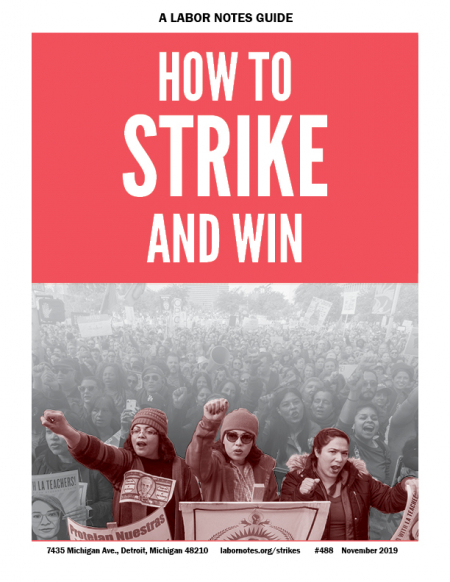How Strikes Lose

The PATCO strike was one of a number of high-profile strikes where heroic workers took a brave risk and a big fall. Photo: Jim West / jimwestphoto.com.
Any plan to revive the strike must take the risks seriously. There are good reasons not to strike too hastily.
How to Strike and Win
A Labor Notes Guide
labornotes.org/strikes
The Big Picture
Know Your ABC's
Building Blocks
- Turn Up the Heat
- Organize the Organized
- Democracy: Who Owns the Strike?
- Community: Who Else Owns It?
- How to End a Strike
At a Glance
The past few decades have seen a number of high-profile strikes where heroic workers took a brave risk and a big fall. The stories behind these losses reveal some ways your strike could go off the rails.
FEAR OF PERMANENT REPLACEMENTS
One painful lesson is the incredible damage caused when employers discovered that they could tell strikers, “Don’t come back!”
Permanent replacements, described by a former Labor Board chair as the “nuclear weaponry in the arsenal of industrial warfare,” were relatively rare in the post-World War II era. But that changed when President Ronald Reagan broke the Professional Air Traffic Controllers Organization strike in 1981. All 11,000 PATCO members were fired and blacklisted. They were never allowed to work for the federal government again.
In hindsight, the Air Traffic Controllers’ strike looks reckless. They charged out on strike alone, without asking other unions for support. They made no plan to develop public sympathy for the $5,000 pay hike they were demanding, at a time when wages were in decline.
But they had reason to be confident— and not just because PATCO had backed Reagan’s election. As highly skilled workers, they were difficult to replace.
“Most employers would have to be pragmatic and say, ‘We will get rid of the ringleaders and everyone who comes back on our terms will be allowed to work,’” said labor historian Joseph McCartin, author of Collision Course: Ronald Reagan, the Air Traffic Controllers, and the Strike that Changed America.
Instead, “Reagan broke this strike in a nuclear fashion, and on the biggest public stage imaginable.” He showed that it's possible to find or train replacements even for a highly skilled workforce.
The genie was out of the bottle. Ever since then, employers have known they have the option to use permanent scabs to break strikes.
That doesn’t mean they’ll do it. A mass firing has serious consequences that employers weigh—chaos on the job, sometimes a lack of qualified replacements, damage to profits, quality, and public image.
But by adding this card to the deck, Reagan upped the fear factor. Employers were quick to use the threat against strikers, and “in almost every case the unions buckled and in some cases the companies got rid of the union entirely,” McCartin said.
If you’re planning an open-ended strike, you’ll need a plan to counter this threat. One approach is to make your strike an unfair labor practice strike, which grants you legal protection against permanent replacements, so long as the courts uphold the ULP (see here).
Or you may need to make it too hard for your employer to bring in scabs, by occupying or blocking access to the workplace (but note these tactics are generally illegal. see here), or by rallying enough public sympathy and attention to your cause (see here).
No matter what, you’ll need to inoculate your co-workers to expect to hear this threat, and make sure everyone knows the union’s plan.
LACK OF PREPARATION

SUPPORT LABOR NOTES
BECOME A MONTHLY DONOR
Give $10 a month or more and get our "Fight the Boss, Build the Union" T-shirt.
The picket line chant “One day longer, one day stronger” is inspiring—but not always accurate. Some strikes peter out, with strikers feeling the pinch and no win in sight.
Southern California grocery workers walked the picket lines for five months in 2004, with 91 percent participating right through to the end—yet they returned to work feeling bitter.
“They got two-tier,” Lonnie Hardy, a member of Food and Commercial Workers (UFCW) Local 1036, told Labor Notes. “Everything we were going against, they got. When you stay out for five months, you want to gain something, not lose what you had.”
Years in advance the grocery chains had telegraphed their intentions to demand two-tier pay. Yet the union didn’t take advantage of this time to start organizing a member-driven contract campaign (see here), nor to build public support, nor to coordinate a national campaign across locals with similar contract timelines and common issues.
The union also failed to make full use of the leverage it had. It never called a consumer boycott, never got the Teamsters who represented the grocery chains’ warehouse workers and truck drivers fully on board, and quickly backed off its picketing at the distribution centers, which were key chokepoints.
To win, unions have to be prepared to go the distance. The Detroit newspapers strike and lockout of 1995-2001 is an example where the unions thought they could win quickly, simply by withholding labor. But the local operation was part of a larger conglomerate with many other sources of revenue—and management had prepared well in advance to provoke a strike, specifically to break the unions.
Members were out of work for years. “We told people they needed to consolidate their bills after we went out,” said Barbara Ingalls, a member of the Detroit Typographical Union. “That should have happened six months before. Everyone should have zero credit card debt. You don’t want people to lose their house and their family.”
SABOTAGE FROM ABOVE
UFCW Local P-9 went on strike against concessions at the Hormel meatpacking plant in Austin, Minnesota, in 1985. It was P-9’s first strike since 1933 and came over the objections of the UFCW International, which urged workers to accept the givebacks.
Unlike PATCO, P-9 galvanized community and labor support. One of its innovations was a “road warrior” program, which sent strikers around the country to speak to other unions and community groups.
But it wasn’t enough. A few months into the strike, Hormel hired permanent replacements and locked out the union. The International ended the conflict by removing P-9’s leaders and agreeing to the concessions the union had struck against in the first place.
Before walking out, assess what role you can expect your international union leaders to play. Will they be helpful, neutral, or another adversary? How much power will they have to undermine you? You may have to fight on two fronts.
LACK OF LEVERAGE
To avoid being permanently replaced in a strike, workers at the A.E. Staley corn processing plant in Decatur, Illinois, chose to stay on the job and fight. They waged an effective work-to-rule campaign for months before the employer lashed back in 1995, locking them all out.
In the lockout, the union did many things right. It started its own “road warrior” program, modeled on P-9’s. Solidarity committees popped up across the Midwest.
Workers led demonstrations and sat down in civil disobedience in front of the plant, where they were pepper-sprayed by police. Again the workers did not have the support of their International, which was fearful of being sued.
But in the end, none of the workers’ efforts were enough to hammer the revenue of a massive multinational corporation.
“It was an utter defeat for the workers. Staley got the contract they wanted and the bulk of union workers did not go back,” said Steve Ashby, who was deeply involved in organizing solidarity actions for Staley workers and co-authored Staley: The Fight for a New American Labor Movement.
The biggest lesson: when an enormous employer can eat the lost production at your workplace, you will have to shut down its capacity elsewhere. That is why national and international solidarity is so important.
“At the end of the day, if the employer can continue production with scabs and you can’t stop production or stop the sale of products, then it is impossible to win,” said Joe Burns, author of Reviving the Strike: How Working People Can Regain Power and Transform America. Don’t walk out without a well-considered plan to win.





